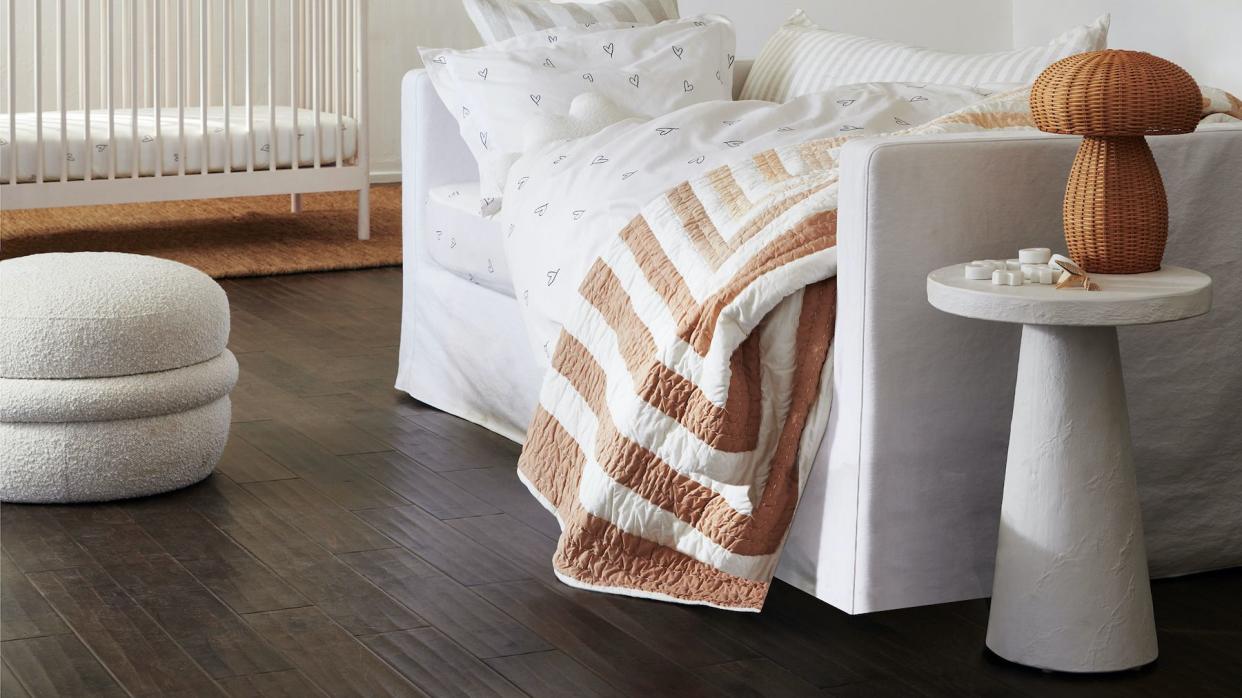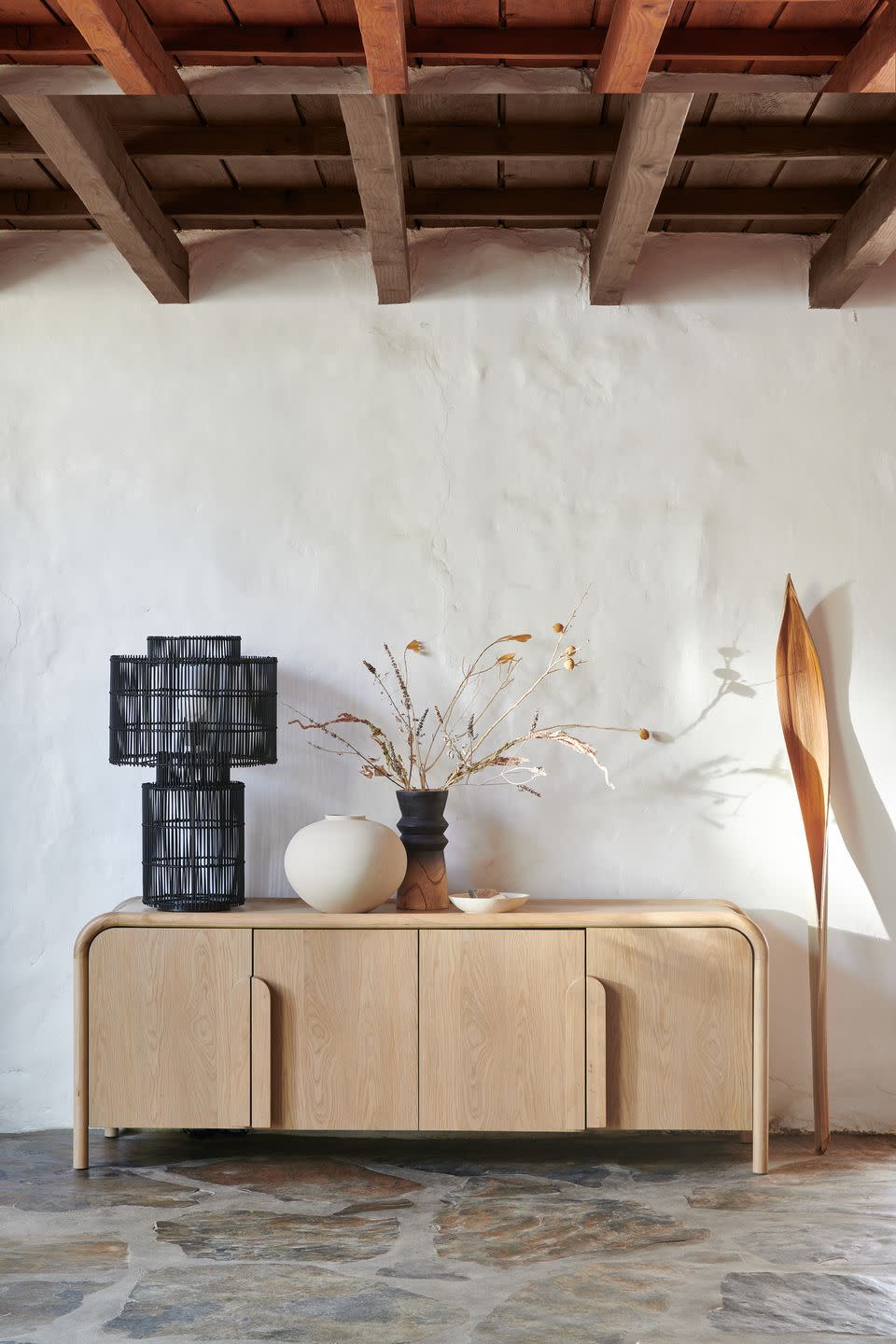This Textured Wall Finish Is Leanne Ford's Best-Kept Secret

[table-of-contents] stripped
If you love the look of a neutral interior with lots of texture à la Leanne Ford, chances are you've heard of microcement. The popular decorative wall finish (also sometimes called microconcrete) is a thin coating that you can use indoors or out and that's especially popular for bathrooms, kitchens, and terraces. It's similar to other textural coatings like limewash and Roman clay, but it has its own unique advantages and disadvantages (more on those below).
There are lots of reasons to love microcement. For starters, it's subtle, but it can bring so much character to a room. "I'm always looking for ways to bring earth or soul into a space," says Ford, and a microcement finish is one way she does that. Also, it's rustic but not too rustic—it can be quite uniform and seamless. It's extremely helpful when you want a quick design change, since it easily bonds to drywall or existing materials like tile. And perhaps best of all, it's customizable and comes in different colors and finishes, so you can get the exact look you want.
If you've heard all the fuss about microcement and want to learn more or are trying to decide which finish is right for your walls, read on. Our guide walks you through the different application techniques, types, and pros and cons of microcement, with advice and DIY tips from Ford herself.
What Is Microcement?
Microcements (or microconcrete) are thin coatings (think 3mm) that can be applied to indoor and outdoor surfaces. Most microcements are made up of water-based resins, cement, additives, and mineral pigments, though every type has its own unique makeup. The price per square foot for a microcement treatment can vary from $14 to $20, depending on your project's complexity and size.

Where to Use Microcement
Microcements are typically "applied to drywall for some extra oomph, says Ford, "but I have covered tile and other surfaces with them before." Really, the sky's the limit. You can apply microcement to practically any surface, indoors or outdoors. It's especially great for floors and walls in damp areas like kitchens and bathrooms because it's seamless. You can even use it to coat showers and bathtubs. Outdoors, it's popular for patios and terraces, stairs, and walls, and can be used for swimming pools. Benches and other furniture can be coated in microcement too.
Just keep in mind that different types of microcement are best for different applications, so think through where you want to use it before you start shopping. For example, Ford recommends SureCrete for bathrooms and other damp areas because it can be sealed and waterproofed.
Types of Microcement
There are a number of microcements to choose from, but the most common types are cement based, water based, and UV based.
Cement-Based Microcement
A cement-based microcement is the easiest to use and the most cost effective. It's a suitable option for DIYers who want to coat an indoor or outdoor area of their home.
Water-Based Microcement
A water-based coating is more versatile and comes in more finishes than a cement-based coating, including a textured effect, but it's not beginner friendly. These microcements require professional application, but that can be worth the investment because they're durable, stain resistant, and nonporous. They're your best bet for a wet area like a bathroom or kitchen.
UV-Based Microcement
The best of the three options for the outdoors, a UV-based microcement—also known as a polyurethane-based microcement—combines polyurethane with cement and other additives to create a durable coating that's resistant to stains, erosion, and UV rays. Similar to a water-based coating, UV-based microcement calls for professional installation. Its pricey, but it gives you a long-lasting, heavy-duty finish. This is what you want if you're doing a patio or a pool, especially if you want a custom color.
Pros and Cons of Microcement
You have lots of options to create a textured wall. Microcement is just one, and it has its advantages and disadvantages compared with similar treatments like limewash.
Pros of Microcement
Waterproof
Stain and scuff resistant
Can be applied directly to tile
Can cover resin, plywood, and other common building materials
Cons of Microcement
May require pro installation
Can be more pricier than similar finishes
Microcement Finishes and Textures
As with paint, you can get a matte, satin, or glossy finish depending on the type of microcement you use. When shopping for microcement, consider how your coating will align with your decor. A glossy finish can give "the visual of texture without physically having texture," Ford says, while a matte or semi-matte finish is more subtle and muted. If you want a coating that's not too extravagant but not dull, a satin finish is best.
Microcements are customizable, so you can also achieve rough or fine texture. A fine texture is great for a minimalist or contemporary design because it's smooth, uniform, and modern, whereas a rough texture leans more rustic and has a natural, organic appearance.
Microcement Colors
Microcement colors aren't quite as numerous as paint colors, but there's a rainbow of options to choose from, depending on the brand you decide to use. Most microcements come in natural colors but are also available in bright hues like blue or red.
Ultimately, the color, texture, or finish of microcement you choose is your decision. Consider how you want your home to look like and feel. Because, really, there's no better coating than this durable and versatile material that gives your living space its own character and uniqueness.
Is Microcement Easy to DIY?
Certain microcements, like SureCrete, are suitable for DIY projects. It "tends to be more forgiving because texture is the end goal," Ford says. "You don't have to be too precious when doing it." Still, she recommends thinking it through before you get started. "You better be ready to get messy if you do it yourself," she adds. "And if you tend to be a perfectionist about things, it might be better to leave this one for the professionals."
You Might Also Like
